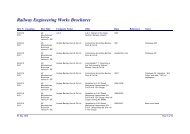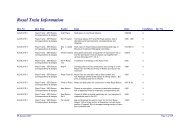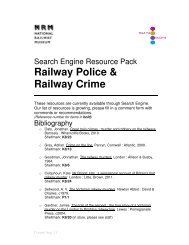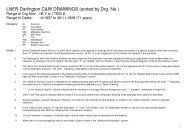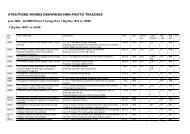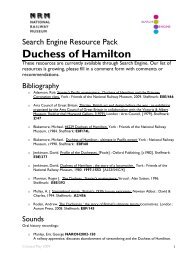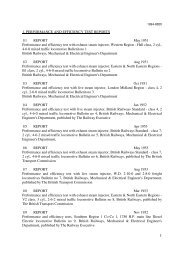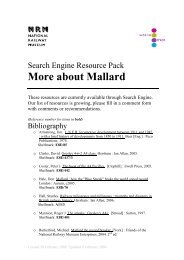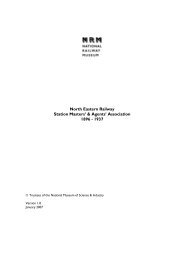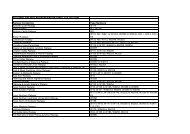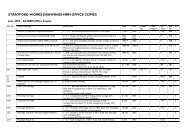Gorton Works Collection of Engineering Drawings in - National ...
Gorton Works Collection of Engineering Drawings in - National ...
Gorton Works Collection of Engineering Drawings in - National ...
You also want an ePaper? Increase the reach of your titles
YUMPU automatically turns print PDFs into web optimized ePapers that Google loves.
<strong>Gorton</strong> <strong>Works</strong>: <strong>Eng<strong>in</strong>eer<strong>in</strong>g</strong> <strong>Draw<strong>in</strong>gs</strong> <strong>in</strong> Contractors’ RollsReference Code(s): GB 0756 2000-8117Title: <strong>Gorton</strong> <strong>Works</strong>: <strong>Collection</strong> <strong>of</strong> eng<strong>in</strong>eer<strong>in</strong>g draw<strong>in</strong>gs <strong>in</strong> contractors’ rollsDates: c 1850-1950Level <strong>of</strong> Description: FondsExtent & Medium <strong>of</strong> the unit <strong>of</strong> the unit <strong>of</strong> description:The collection consists <strong>of</strong> 5313 surviv<strong>in</strong>g draw<strong>in</strong>gs relat<strong>in</strong>g to 44 rolls <strong>of</strong> eng<strong>in</strong>eer<strong>in</strong>gdraw<strong>in</strong>gs. The rolls are each to a small extent <strong>in</strong>complete, pr<strong>in</strong>ted on wax l<strong>in</strong>en andattached to polished wooden rods. There are a small number <strong>of</strong> loose draw<strong>in</strong>gsboxed separately without an <strong>in</strong>dex.Name <strong>of</strong> creators: <strong>Gorton</strong> <strong>Works</strong> Draw<strong>in</strong>g OfficeAdm<strong>in</strong>istrative/Biographical History:Dur<strong>in</strong>g the early 1840s several companies were <strong>in</strong> negotiations for what would later be theformation <strong>of</strong> the Manchester, Sheffield and L<strong>in</strong>colnshire Railway. One <strong>of</strong> these companieswas the Sheffield, Ashton-under-Lyne and Manchester Railway. On 27 August 1845 theboard <strong>of</strong> the SA&M decided to construct a locomotive depot and works, chose land at<strong>Gorton</strong> on the outskirts <strong>of</strong> Manchester and approved plans for construction on 4 March1846. The works were planned by the locomotive super<strong>in</strong>tendent Richard Peacock, thenaged 26, who later became a partner <strong>in</strong> Beyer Peacock & Co. In the early 1850s heestablished their works directly opposite <strong>Gorton</strong> <strong>Works</strong>.The works were completed by 1848. There were separate depots for locomotive work andfor carriage and wagon work, the latter be<strong>in</strong>g on two floors with an elaborate lift system totake carriages to and from the first floor. In the early years work was conf<strong>in</strong>ed to repairsand adjustments. A decision to build locomotives was made <strong>in</strong> 1857 and the first <strong>Gorton</strong>builtlocomotive appeared <strong>in</strong> 1858.For the whole <strong>of</strong> the life <strong>of</strong> the <strong>Works</strong> it was common to outsource construction, pr<strong>in</strong>cipallyto Kitson & Co Ltd <strong>of</strong> Leeds, Beyer Peacock next door <strong>in</strong> <strong>Gorton</strong>, and Neilson & Co <strong>of</strong>Glasgow. Other contributors to the fleet <strong>in</strong>cluded Stephensons, Armstrong Whitworth andSharp Stewart.Always conf<strong>in</strong>ed as to space the <strong>Gorton</strong> <strong>Works</strong> soon earned the nickname <strong>of</strong> ‘The Tank’.Overcrowd<strong>in</strong>g became such that <strong>in</strong> 1910 a new site was opened at Duk<strong>in</strong>field, to whichcarriage and wagon work was transferred <strong>in</strong> 1910.In 1897 the MS&LR was re-styled as the Great Central Railway <strong>in</strong> anticipation <strong>of</strong> thecompletion <strong>of</strong> its London extension. Its headquarters were removed to the LondonTerm<strong>in</strong>us at Marylebone. Follow<strong>in</strong>g amalgamation under the post-war group<strong>in</strong>g scheme <strong>in</strong>1922 the GCR became <strong>in</strong> turn part <strong>of</strong> the London and North Eastern Railway. Locomotiveconstruction was <strong>in</strong>creas<strong>in</strong>gly concentrated on the Darl<strong>in</strong>gton and Doncaster works, thougha small amount cont<strong>in</strong>ued after nationalisation under the aegis <strong>of</strong> British Railways. The lastlocomotives were built dur<strong>in</strong>g 1950.



